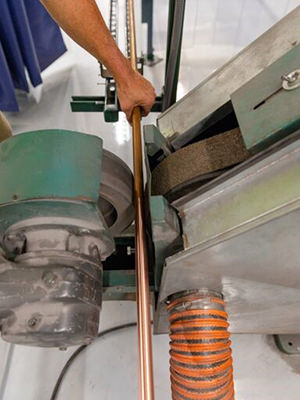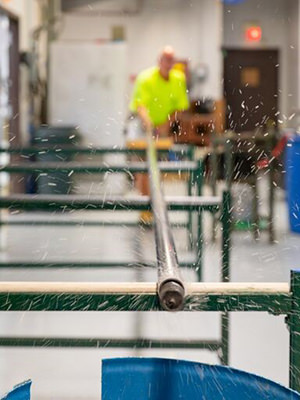Precision Mechanical Polishing Services for Metal Finishing
Mechanical polishing creates a smooth, uniform, and bright finish on tubing by using progressively finer abrasives. For ornamental purposes, finishes range from mill finish and bright finish to 180, 240, or 400 grit polish, with finer options available upon request. For sanitary tubing, both the inside and outside are polished to create a smooth surface that helps prevent biological buildup. Mechanical polishing can also prepare tubing for electropolishing to achieve the desired final finish.
Contact Us Today!
 What is mechanical polishing?
What is mechanical polishing?
- Removes surface irregularities and imperfections (weld slag, paint, loose scale, and dirt)
- Improves metal durability and longevity
- Enhances smoothness for a high-quality finish
What can be mechanically polished?
Components, Parts & Systems that can be polished include:
- Tube, Pipe, Spools, Manifolds, and Fittings
- Heat Exchangers
- Valves
- Fabricated Specials
- Copper, Carbon, and Stainless Steel
 Key Benefits of Mechanical Polishing
Key Benefits of Mechanical Polishing
- Surface Smoothing: Reduces roughness, creating a uniform finish
- Increased Durability: Enhanced wear resistance for longer-lasting components
- Contaminant Removal: Eliminates surface contaminants and embedded debris
- Enhanced Aesthetics: Achieves a visually appealing, high-luster finish
Industries We Serve
- Medical Devices: Surgical tools, implants, and medical equipment
- Aerospace: Precision-engineered components requiring high tolerance
- Food & Beverage: Sanitary stainless steel surfaces for processing equipment
- Pharmaceutical & Biotech: Contamination-free, smooth metal surfaces
- Automotive: High-performance parts with superior finish
Our Mechanical Polishing Process
- Surface Preparation: Cleaning and initial assessment of the material
- Abrasive Polishing:Step-by-step refinement using specialized polishing compounds
- Final Buffing: Achieving a mirror-like or satin finish per specifications
- Quality Inspection: Ensuring compliance with industry standards
Why Choose HPT for Mechanical Polishing?
With decades of experience in high-tolerance metal finishing, HPT delivers precision and expertise backed by advanced facilities that support both small-batch and large-scale production. Our custom polishing solutions are tailored to meet your exact needs while complying with ASTM, ISO and industry-specific standards.
Frequently Asked Questions (FAQs)
What is passivation?
Passivation is a chemical treatment—usually with nitric or citric acid—that forms a protective oxidized layer on stainless steel. This layer boosts corrosion resistance by removing iron particles introduced during fabrication, which could otherwise cause rust or pitting. It’s typically the final step in processing, done via acid bath or swab application, followed by rinsing and drying. Clean surfaces are essential for effective treatment.
What can be passivated?
HPT can help determine which parts need passivation. We clean, inspect, and package all materials—like tubing, valves, and heat exchangers—per ASTM standards in our on-site class 10,000 cleanroom. Materials include stainless steel, copper, and carbon steel. All polished/passivated items are certified to HPT-500/500A specs and available with expedited lead times.